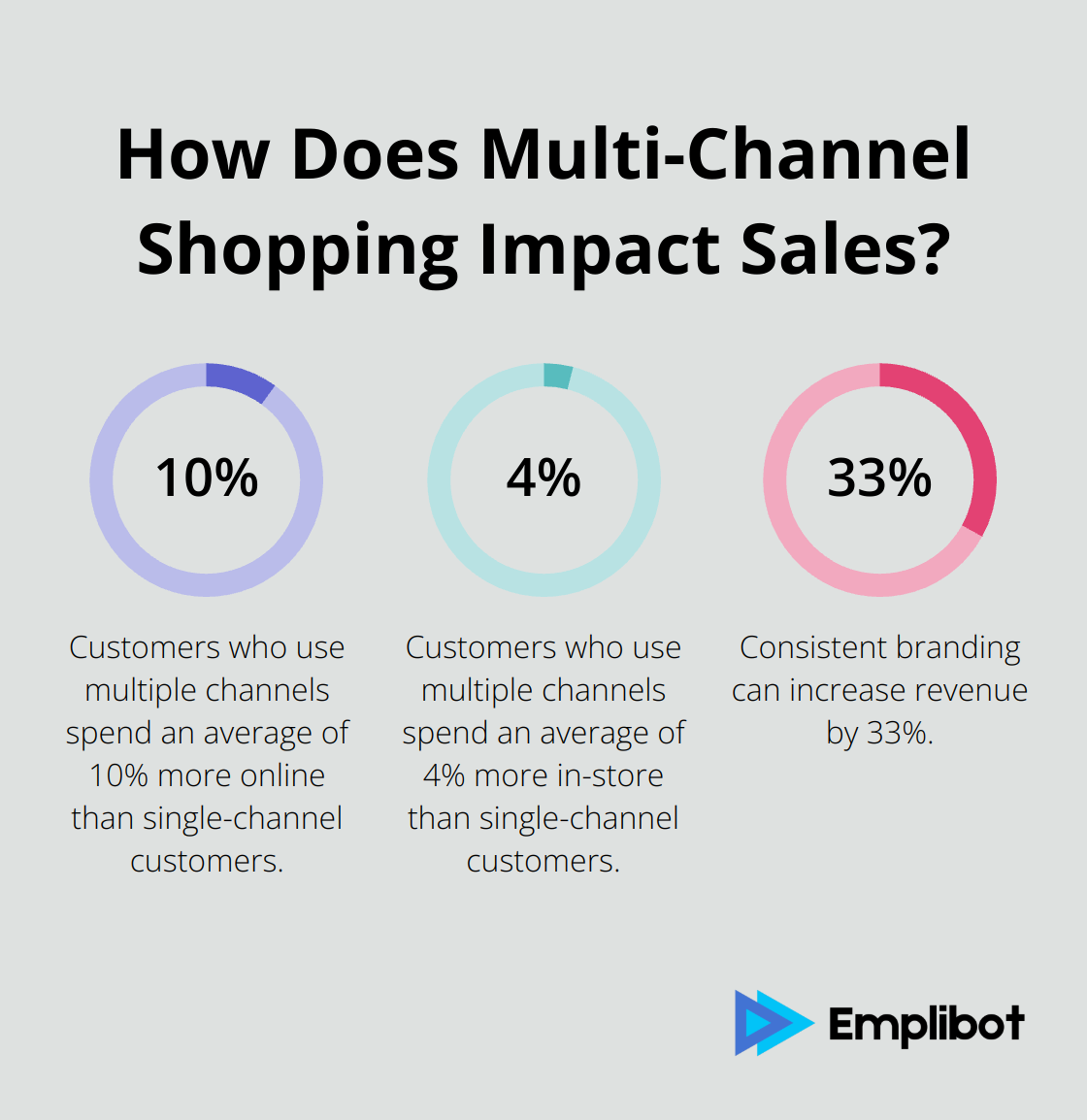Marketing has evolved into a complex landscape, blending traditional methods with digital innovations. At Emplibot, we’ve seen firsthand how businesses struggle to navigate the myriad of online and offline marketing channels available today.
This guide will break down the most effective marketing channels, both digital and traditional, to help you craft a comprehensive strategy. We’ll also explore how to integrate these channels for maximum impact and discuss emerging trends shaping the future of marketing.
Contents
ToggleHow to Leverage Online Marketing Channels
Online marketing channels have become essential for businesses aiming to expand their reach and drive growth in the digital age. Let’s explore the most effective online marketing channels and how you can use them for your business.
Search Engine Optimization (SEO): The Foundation of Online Visibility
SEO remains the cornerstone of online visibility. BrightEdge reports that 53.3% of all website traffic comes from organic search. To improve your SEO:
- Create high-quality, relevant content that answers your audience’s questions.
- Optimize your website’s technical aspects (including page speed and mobile responsiveness).
- Build authoritative backlinks through guest posting and partnerships.
Pay-Per-Click (PPC) Advertising: Immediate Visibility and Precise Targeting
PPC advertising offers quick visibility and accurate targeting. To maximize PPC:
- Conduct thorough keyword research to target high-intent searches.
- Create compelling ad copy that highlights your unique selling propositions.
- Use ad extensions to provide additional information and increase click-through rates.
Social Media Marketing: Tapping into a Vast Audience
Social media platforms offer unparalleled reach. To succeed in social media marketing:
- Choose platforms where your target audience is most active.
- Create a content calendar to maintain consistency and engagement.
- Use social media advertising to boost your organic efforts and reach new audiences.
Content Marketing: The Engine of Online Success
Content marketing drives SEO, social media, and email marketing efforts. To excel in content marketing:
- Develop a content strategy aligned with your business goals and audience needs.
- Create a mix of content types (including blog posts, videos, and infographics).
- Repurpose content across different channels to maximize its impact.
Email Marketing: The ROI Champion
Email marketing delivers an average return of $42 for every $1 spent. To optimize your email marketing:
- Segment your email list to deliver more personalized content.
- Use automation to send timely, relevant emails based on user behavior.
- A/B test your subject lines, content, and send times to improve open and click-through rates.

These online marketing channels can significantly boost your online presence and drive business growth when used effectively. However, it’s important to note that offline marketing channels still play a vital role in many industries. In the next section, we’ll explore how traditional marketing methods can complement your digital efforts and create a well-rounded marketing strategy.
How Offline Marketing Channels Boost Your Business
Offline marketing channels remain powerful tools for businesses, complementing digital strategies to create a comprehensive marketing approach. This chapter explores the enduring impact of traditional methods and how they can enhance your overall marketing efforts.
Print Advertising: A Trusted Medium
Print advertising continues to hold sway, especially in local markets. A study by MarketingSherpa found that 82% of consumers trust print ads when making purchasing decisions. To maximize your print advertising efforts:
- Target local publications that align with your audience demographics.
- Use eye-catching designs and clear calls-to-action.
- Include trackable elements (like unique phone numbers or QR codes) to measure effectiveness.
Broadcast Media: Reaching Large Audiences
Television and radio advertising can reach large audiences quickly. Nielsen reports that adults in the United States spend an average of 4 hours and 27 minutes watching TV daily. To make the most of broadcast advertising:
- Choose time slots that align with your target audience’s viewing or listening habits.
- Create memorable jingles or taglines to increase brand recall.
- Use storytelling techniques to engage viewers emotionally.
Direct Mail: Personal and Tangible
Direct mail offers a personal touch that digital channels often lack. The Data & Marketing Association found that direct mail achieves a 9% response rate with house lists. To optimize your direct mail campaigns:
- Personalize mailings using customer data.
- Use high-quality materials to stand out in recipients’ mailboxes.
- Include clear, compelling offers and easy response mechanisms.
Face-to-Face Interactions: Building Personal Connections
Trade shows and events provide invaluable opportunities for personal connections. 81% of trade show attendees have buying authority. To maximize your presence at these events:
- Design an eye-catching booth that reflects your brand identity.
- Train staff to engage visitors effectively and qualify leads.
- Follow up promptly with contacts made during the event.
Outdoor Advertising: Creating Lasting Impressions
Outdoor advertising can create lasting impressions on a large scale. The Outdoor Advertising Association of America states that 71% of consumers often look at roadside billboards. To make your outdoor advertising effective:
- Use bold, simple designs that can be understood quickly.
- Choose strategic locations with high visibility and relevant foot or vehicle traffic.
- Incorporate digital elements, like changing displays, to capture attention.

These offline marketing channels, when strategically incorporated into your overall strategy, can create a well-rounded approach that reaches customers through multiple touchpoints. The next chapter will explore how to effectively integrate these traditional methods with your digital efforts for maximum impact.
How to Blend Online and Offline Marketing
The modern marketing landscape demands a seamless integration of online and offline strategies. We’ll explore practical ways to create a cohesive marketing experience that resonates with your audience across all touchpoints.
Unify Your Brand Voice
Consistency builds trust and reinforces brand recognition. A study found that consistent branding can increase revenue by 33%. To achieve this:
- Develop a comprehensive brand guide that outlines your voice, tone, and visual elements.
- Train all team members on your brand guidelines.
- Regularly audit your marketing materials across channels to ensure consistency.
Bridge Digital and Physical with QR Codes
QR codes transform static print ads into interactive experiences, driving offline audiences to digital platforms. The number of US consumers scanning QR codes is expected to grow by 16 million between 2022 and 2025. Try these effective QR code strategies:
- Place them on print ads, product packaging, and in-store displays.
- Link to exclusive content, special offers, or product information pages.
- Use dynamic QR codes that allow you to change the destination URL without reprinting materials.
Harness Data for Personalized Experiences
Integrating customer data from both online and offline sources allows for more personalized and effective marketing. A report by Segment found that 49% of consumers have made impulse purchases after receiving a more personalized experience. To leverage customer data effectively:
- Implement a robust Customer Relationship Management (CRM) system that consolidates data from all touchpoints.
- Use offline purchase history to inform online product recommendations.
- Personalize email campaigns based on in-store interactions (and vice versa).
Create Cross-Channel Promotions
Cross-channel promotions encourage customers to engage with your brand across multiple platforms. A study by Harvard Business Review found that customers who use multiple channels spend an average of 4% more in-store and 10% more online than single-channel customers. To implement effective cross-channel promotions:
- Offer exclusive online discounts that customers can redeem in-store.
- Create social media contests that require in-store participation.
- Use geofencing to send mobile notifications with special offers to customers near your physical locations.

These strategies create a cohesive marketing approach that leverages the strengths of both online and offline channels. The goal is to provide a seamless experience for your customers, regardless of how they choose to interact with your brand.
Wrapping Up
Online and offline marketing channels offer unique advantages in today’s competitive business environment. Digital platforms provide precision, measurability, and global reach, while traditional methods excel in building trust and creating memorable experiences. The most effective strategies integrate both approaches to create a seamless customer experience that reinforces brand messaging across all touchpoints.

The future of marketing will see even greater integration of online and offline channels. Emerging technologies will create new opportunities for immersive, personalized marketing experiences that adapt to changing consumer behaviors. Businesses must understand and leverage both digital and traditional methods to maximize their reach and engage customers effectively.
Tools like Emplibot can help businesses navigate this complex marketing landscape. Emplibot automates content creation and distribution across various online channels, allowing companies to maintain a consistent presence while focusing on offline strategies and overall marketing integration. This balanced approach will drive sustainable growth in an ever-evolving marketplace.










 Rated Excellent 4.5
Rated Excellent 4.5